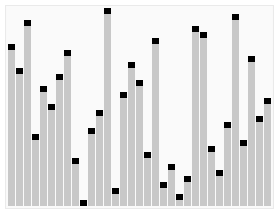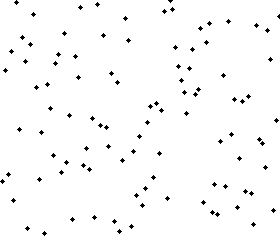📂 collctions
Golang 实现的 collections 模块,灵感来自 Python queue 和 Python collections





📚 目录
🔰 安装&引用
$ go get github.com/chenjiandongx/collections
import "github.com/chenjiandongx/collections"
📦 Collections
Queue
先进先出队列(线程安全)
📝 方法集
Get()(interface{}, bool) // 出队
Put(v interface{}) // 入队
Qsize() int // 返回队列长度
IsEmpty() bool // 判断队列是否为空
✏️ 示例
var nums = 1000
q := collections.NewQueue()
var item interface{}
var ok bool
for i := 0; i < nums; i++ {
q.Put(i)
}
for i := 0; i < nums; i++ {
if item, ok = q.Get(); ok {
fmt.Println(item.(int))
}
}
fmt.Println(q.IsEmpty())
fmt.Println(q.Qsize())
LifoQueue
后进先出队列(线程安全)
📝 方法集
Get()(interface{}, bool) // 出队
Put(v interface{}) // 入队
Qsize() int // 返回队列长度
IsEmpty() bool // 判断队列是否为空
✏️ 示例
var nums = 1000
q := collections.NewLifoQueue()
var item interface{}
var ok bool
for i := 0; i < nums; i++ {
q.Put(i)
}
for i := nums-1; i >=0; i-- {
if item, ok = q.Get(); ok {
fmt.Println(item.(int))
}
}
fmt.Println(q.IsEmpty())
fmt.Println(q.Qsize())
PriorityQueue
优先队列(线程安全)
📝 方法集
Get()(interface{}, bool) // 出队
Put(v *PqNode) // 入队
Qsize() int // 返回队列长度
IsEmpty() bool // 判断队列是否为空
// 优先队列节点
type PqNode struct {
Value string
Priority, index int
}
✏️ 示例
var nums = 1000
q := collections.NewPriorityQueue()
for i := 0; i < nums; i++ {
r := rand.Int()
q.Put(&collections.PqNode{Value: string(r), Priority: rand.Int()})
}
for i := 0; i < nums/2; i++ {
item1, _ := q.Get()
item2, _ := q.Get()
fmt.Println(item1.(*collections.PqNode).Priority > item2.(*collections.PqNode).Priority)
}
fmt.Println(q.IsEmpty())
fmt.Println(q.Qsize())
Deque
双端队列(线程安全)
📝 方法集
GetLeft()(interface{}, bool) // 左边出队
GetRight()(interface{}, bool) // 右边出队
PutLeft(v interface{}) // 左边入队
PutRight(v interface{}) // 右边入队
Qsize() int // 返回队列长度
IsEmpty() bool // 判断队列是否为空
✏️ 示例
var nums = 1000
q := collections.NewDeque()
var item interface{}
var ok bool
for i := 0; i < nums; i++ {
q.PutLeft(i)
}
fmt.Println(q.Qsize())
for i := nums - 1; i >= 0; i-- {
q.PutRight(i)
}
fmt.Println(q.Qsize())
for i := 0; i < nums; i++ {
item, ok = q.GetRight()
fmt.Println(item, ok)
}
for i := nums - 1; i >= 0; i-- {
item, ok = q.GetLeft()
fmt.Println(item, ok)
}
item, ok = q.GetLeft()
fmt.Println(item, ok)
item, ok = q.GetRight()
fmt.Println(item, ok)
OrderedMap
有序 Map,接口设计参考 cevaris/ordered_map
📝 方法集
Set(key, value interface{}) // 新增键值对
Get(key interface{}) (interface{}, bool) // 取值
Delete(key interface{}) bool // 删除键
Iter() (interface{}, interface{}, bool) // 遍历
Len() int // 键值对数量
// 指针回退到 Head,遍历时 current 指针会向后移动 BackToHead 使其移动到头指针,以便下一次从头遍历
BackToHead()
✏️ 示例
maxNum := 100
om := collections.NewOrderedMap()
for i := 0; i < maxNum; i++ {
om.Set(i, i+1)
}
fmt.Println(om.Len())
om.Delete(0)
fmt.Println(om.Len())
for k, v, ok := om.Iter(); ok; k, v, ok = om.Iter() {
fmt.Println(k, v)
}
om.BackToHead()
for k, v, ok := om.Iter(); ok; k, v, ok = om.Iter() {
fmt.Println(k, v)
}
📣 讨论
有序 Map 在 Golang 中应该是十分常见的需求,Map 最大的优势就是其查找性能,理论上 Map 查找的时间复杂度为常数级。但实际情况我们可以通过 benchmark 来验证。在 Go Maps Don’t Appear to be O(1) 这篇文章中,作者测试了 Golang Map 查找的实际性能,不过作者是基于 Go1.4 的,版本有点旧了。下面是我修改了作者的测试案例后在 Go1.10 下跑出来的结果。

上图是使用 go-echarts 绘制的。测试通过与二分查找对比,二分查找的时间复杂度为 O(log2n)。很明显,在 10e5 数量级下两者的性能差别还不是特别大,主要差距是在 10e6 后体现的。结论:Map 的性能优于 O(log2n),但不是常数级。
collections.OrderdMap 🆚 cevaris/ordered_map
本来我一直使用的是 cevaris/ordered_map,后来自己重新实现了一个。实现完就与其进行了性能测试对比,它是基于两个 Map 实现的,而我是使用的 Map+LinkedList,LinkedList 在删除和插入操作上的时间复杂度都是 O(1),用其来存储 Map key 的顺序是一个很好的选择。
同样的测试代码,BenchMark 结果如下
goos: windows
goarch: amd64
pkg: github.com/chenjiandongx/collections
BenchmarkCollectionsSet-8 2000000 689 ns/op 187 B/op 3 allocs/op
BenchmarkCevarisSet-8 1000000 1212 ns/op 334 B/op 3 allocs/op
BenchmarkCollectionsGet-8 2000000 823 ns/op 187 B/op 3 allocs/op
BenchmarkCevarisGet-8 1000000 1281 ns/op 334 B/op 3 allocs/op
BenchmarkCollectionsIter-8 2000000 670 ns/op 187 B/op 3 allocs/op
BenchmarkCevarisIter-8 1000000 1341 ns/op 366 B/op 4 allocs/op
collections.OrderedMap Win 🖖 性能+内存占用全部占优 🚀
Counter
计数器
📝 方法集
// key-value item
type Item struct {
k interface{}
v int
}
Add(keys ...interface{}) // 新增 item
Get(key interface{}) int // 获取 key 计数
GetAll() []Item // 获取全部 key 计数
Top(n int) []Item // 获取前 key 计数
Delete(key interface{}) bool // 删除 key,成功返回 true,key 不存在返回 false
Len() int // key 数量
✏️ 示例
c := collections.NewCounter()
c.Add("a", "b", "c", "d", "a", "c")
fmt.Println(c.Get("A"))
fmt.Println(c.Get("a"))
fmt.Println(c.Get("b"))
fmt.Println(c.Top(2))
fmt.Println(c.Len())
fmt.Println(c.All())
c.Delete("a")
AVLTree
AVL 二叉自平衡查找树
📝 方法集
NewAVLTree() *AVLTree // 生成 AVL 树
Insert(v int) // 插入节点
Search(v int) bool // 搜索节点
Delete(v int) bool // 删除节点
GetMaxValue() int // 获取所有节点中的最大值
GetMinValue() int // 获取所有节点中的最小值
AllValues() []int // 返回排序后所有值
✏️ 示例
var maxNum = 100
tree := NewAVLTree()
for i := 0; i < maxNum; i++ {
tree.Insert(i)
tree.Insert(maxNum + i)
}
fmt.Println(len(tree.AllValues()))
fmt.Println(tree.GetMaxValue())
fmt.Println(tree.GetMinValue())
fmt.Println(tree.Search(50))
fmt.Println(tree.Search(100))
fmt.Println(tree.Search(-10))
fmt.Println(tree.Delete(-10))
fmt.Println(tree.Delete(10))
📣 讨论
AVL 树是自平衡树的一种,其通过左旋和右旋来调整自身的平衡性,使其左右子树的高度差最大不超过 1。AVL 在插入、查找、删除的平时时间复杂度都是 O(logn),在基本的 BST(二叉查找树)中,理想情况的效率也是为 O(logn),但由于操作的性能其实是依赖于树的高度,BST 最坏的情况会导致树退化成链表,此时时间复杂度就变为 O(n),为了解决这个问题,自平衡二叉树应运而生。
AVL 的主要精髓在于旋转,旋转分为 4 种情况,左旋,左旋+右旋,右旋,右旋+左旋。调整树结构后需要重新计算树高。
左子树左节点失衡
左左情况 直接右旋
x
x => 右旋 x
x x x
左子树右节点失衡
左右情况 先左旋后右旋
x x
x => 左旋 x => 右旋 x
x x x x
右子树右节点失衡
右右情况 直接左旋
x
x => 左旋 x
x x x
右子树左节点失衡
右左情况 先右旋后左旋
x x
x => 右旋 x => 左旋 x
x x x x
AVL 主要的性能消耗主要在插入,因为其需要通过旋转来维护树的平衡,但如果使用场景是经常需要排序和查找数据的话,AVL 还是可以展现其良好的性能的。
benchmark
BenchmarkAVLInsert10e1-6 2000000000 0.00 ns/op
BenchmarkAVLInsert10e2-6 2000000000 0.00 ns/op
BenchmarkAVLInsert10e3-6 2000000000 0.00 ns/op
BenchmarkAVLInsert10e4-6 2000000000 0.02 ns/op
BenchmarkAVLInsert10e5-6 1000000000 0.82 ns/op
BenchmarkAVLSearch-6 2000000000 0.00 ns/op
BenchmarkAVLDelete-6 2000000000 0.00 ns/op
Sort
📝 方法集
BubbleSort() // 冒泡排序
InsertionSort() // 插入排序
QuickSort() // 快速排序
ShellSort() // 希尔排序
HeapSort() // 堆排序
MergeSort() // 归并排序
✏️ 示例
var maxCnt = 10e4
func yieldRandomArray() []int {
res := make([]int, maxCnt)
for i := 0; i < maxCnt; i++ {
res[i] = rand.Int()
}
return res
}
BubbleSort(yieldRandomArray())
InsertionSort(yieldRandomArray())
QuickSort(yieldRandomArray())
ShellSort(yieldRandomArray())
HeapSort(yieldRandomArray())
MergeSort(yieldRandomArray())
📣 讨论
排序算法时间复杂度比较
| 排序算法 |
是否稳定 |
平均 |
最好 |
最差 |
动画演示 |
| BubbleSort |
是 |
O(n^2) |
O(n) |
O(n^2) |
 |
| InsertionSort |
是 |
O(n^2) |
O(n) |
O(n^2) |
 |
| QuickSort |
否 |
O(nlogn) |
O(nlogn) |
O(n^2) |
 |
| ShellSort |
否 |
O(nlogn) |
O(n) |
O(n^2) |
 |
| HeapSort |
否 |
O(nlogn) |
O(nlogn) |
O(nlogn) |
 |
| MergeSort |
是 |
O(nlogn) |
O(nlogn) |
O(nlogn) |
 |
通过 benchmark 来测试平均排序性能
数据随机分布
var maxCnt int = 10e4
func yieldRandomArray(cnt int) []int {
res := make([]int, cnt)
for i := 0; i < cnt; i++ {
res[i] = rand.Int()
}
return res
}
运行结果
BenchmarkBubbleSort-8 1 17361549400 ns/op
BenchmarkInsertionSort-8 1 1934826900 ns/op
BenchmarkQuickSort-8 100 10651807 ns/op
BenchmarkShellSort-8 100 16476199 ns/op
BenchmarkHeapSort-8 100 14231607 ns/op
BenchmarkMergeSort-8 100 14840583 ns/op
冒泡和直接插入排序在随机数据集的排序性能最差,为 O(n^2),剩余 4 种排序快排效率最佳,其他 3 者性能很接近。
换两种极端的数据分布方式
数据升序分布
func yieldArrayAsce(cnt int) []int {
res := make([]int, cnt)
for i := 0; i < cnt; i++ {
res[i] = i
}
return res
}
运行结果
BenchmarkBubbleSort-8 5000 266690 ns/op
BenchmarkInsertionSort-8 10000 213429 ns/op
BenchmarkQuickSort-8 1 3291222900 ns/op
BenchmarkShellSort-8 1000 1716406 ns/op
BenchmarkHeapSort-8 200 6806788 ns/op
BenchmarkMergeSort-8 300 4677485 ns/op
在数据基本升序的情况下,冒泡和直接插入排序能够取得良好的性能。而快排就给跪了,就是最差的 O(n^2) 了。
数据降序分布
func yieldArrayDesc(cnt int) []int {
res := make([]int, cnt)
for i := 0; i < cnt; i++ {
res[i] = cnt-i
}
return res
}
运行结果
BenchmarkBubbleSort-8 1 6710048800 ns/op
BenchmarkInsertionSort-8 1 3881599100 ns/op
BenchmarkQuickSort-8 1 3373971200 ns/op
BenchmarkShellSort-8 500 2876371 ns/op
BenchmarkHeapSort-8 200 7081150 ns/op
BenchmarkMergeSort-8 300 4448222 ns/op
在数据基本降序的情况下,冒泡和直接插入排序一如既往的差,快排又给跪了,又是 O(n^2)...
那自己实现的排序和 Golang 官方提供的 sort.Sort 排序方法对比,效率如何呢
定义一个 struct,实现 sort.Interface
import "sort"
type StdItems struct {
data []int
}
func (o StdItems) Less(i, j int) bool {
return o.data[i] < o.data[j]
}
func (o StdItems) Swap(i, j int) {
o.data[i], o.data[j] = o.data[j], o.data[i]
}
func (o StdItems) Len() int {
return len(o.data)
}
只取 n(logn) 复杂度的排序算法与标准 sort 进行对比
数据随机分布
BenchmarkStdSort-8 50 22978524 ns/op
BenchmarkQuickSort-8 100 11648689 ns/op
BenchmarkShellSort-8 100 17353544 ns/op
BenchmarkHeapSort-8 100 14501199 ns/op
BenchmarkMergeSort-8 100 13793086 ns/op
是不是眼前一亮 😂,自己写的快排居然这么厉害,比标准的 sort 快了不止两倍??? 这里出现这种情况的主要原因是 sort 实现了 sort.Interface,该接口需要有三个方法 Less()/Len()/Swap(),而接口的类型转换是有成本的。通用意味着兼容,兼容意味着妥协,这是专和精权衡后的结果。当然,标准的 sort 大部分情况的性能都是可接受的。但当你需要追求极致性能的话,自己针对特定需求实现排序算法肯定会是更好的选择。
数据升序分布
BenchmarkStdSort-8 200 7285511 ns/op
BenchmarkQuickSort-8 1 3351046900 ns/op
BenchmarkShellSort-8 1000 1679506 ns/op
BenchmarkHeapSort-8 200 6632256 ns/op
BenchmarkMergeSort-8 300 4308582 ns/op
是不是又是眼前一亮 🤣,我去 为什么这次标准的排序比快排快了这么多,官方的排序不也是快排吗?(这个测试结果看起来好像也没人会比快排慢是吧 😅)
数据降序分布
BenchmarkStdSort-8 200 7405331 ns/op
BenchmarkQuickSort-8 1 3390954400 ns/op
BenchmarkShellSort-8 500 2900240 ns/op
BenchmarkHeapSort-8 200 7091124 ns/op
BenchmarkMergeSort-8 300 4295169 ns/op
emmmmmmm,同上 😓
关于官方排序的具体实现,可以参考 src/sort/sort.go,实际上是直接插入排序,快速排序,堆排序和归并排序的组合排序。这篇文章 对这部分有介绍
最后,按官方的排序针对自己想要的数据类型排序,但不使用接口那套,对比上面排序中最快的算法以及接口实现的 sort
数据随机分布
BenchmarkStdSort-8 100 22649399 ns/op
BenchmarkQuickSort-8 100 10870924 ns/op
BenchmarkStdSortWithoutInterface-8 100 10511605 ns/op
数据升序分布
BenchmarkStdSort-8 200 7006117 ns/op
BenchmarkShellSort-8 1000 1667537 ns/op
BenchmarkStdSortWithoutInterface-8 1000 1619643 ns/op
数据降序分布
BenchmarkStdSort-8 200 7614625 ns/op
BenchmarkShellSort-8 500 3051834 ns/op
BenchmarkStdSortWithoutInterface-8 1000 1689479 ns/op
🖖 StdSortWithoutInterface 完胜!!!
我们还可以进一步思考如何获得更高的排序性能,使用 goroutine 将一个数据切分成两半,分别使用 StdSortWithoutInterface 排序,将排序后的结果进行一次归并排序,就可以得到最终的有序数组,这次我们测试的数组长度为 10e5
为了验证真正的并行计算 我们将分别测试 cpu 数量为 1, 2, 8 的情况
BenchmarkStdSort 5 260696480 ns/op
BenchmarkStdSort-2 5 246746560 ns/op
BenchmarkStdSort-8 5 248532560 ns/op
BenchmarkStdSortWithoutInterface 10 124666470 ns/op
BenchmarkStdSortWithoutInterface-2 10 120676740 ns/op
BenchmarkStdSortWithoutInterface-8 10 126062650 ns/op
BenchmarkStdSortWithGoroutine 20 125163280 ns/op
BenchmarkStdSortWithGoroutine-2 20 80835825 ns/op
BenchmarkStdSortWithGoroutine-8 20 81232625 ns/op
😎 WOW!!! cpu 数量为 1 时大家相差无几,cpu > 1 以后,goroutine 做到了真正的并行,利用多核进行计算,速度提升了 1.5 倍,比默认的 Sort 方法提升了 4 倍。喏,这就是算法的魅力。
📃 License
MIT ©chenjiandongx
 Documentation
¶
Documentation
¶






